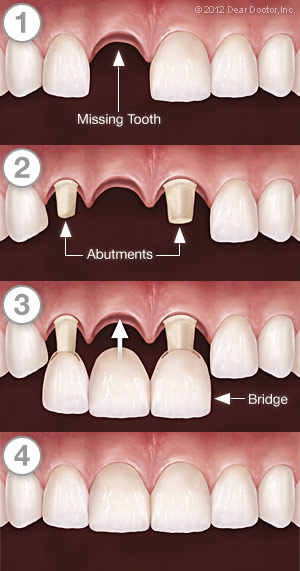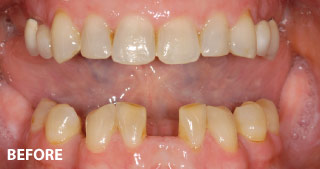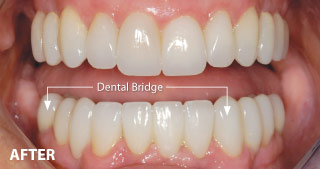Crowns & Bridgework
Traditional Techniques That Are Getting Better With Time
(Continued)
A Bridge to Somewhere

In some cases, a hopelessly damaged tooth cannot be restored even with the use of a crown. Your dentist will then suggest removal of the non-restorable tooth and techniques to preserve the bony socket, and thus the shape of the jawbone.
Many people need to have teeth replaced as a result of decay, abscesses, fractures, or advanced periodontal disease. Replacing missing teeth — even the ones in back — is important to help restore chewing ability as well as preserve the facial contours and re-establish a pleasing smile. A major reason for replacement is to prevent neighboring teeth from drifting into the space left by the missing tooth.
If you need to have a missing or hopelessly damaged tooth replaced, you have two best options: dental implants or bridgework. Bridgework involves crowning teeth on either side of a gap (left by a missing tooth or teeth). These support teeth are known as “abutment” teeth. The abutment teeth are attached to additional crowns in between, which replace the missing teeth and are known as “pontics,” from the French for bridge. To sum up, then, it is the pontics that bridge the gap and the abutments that hold them in place.
Tooth preparation for bridgework is the same as for single crowns. In a bridge, however, all the crowns are joined together like pickets in a fence. Thus a three-unit bridge used to replace one missing tooth has two abutment teeth and one pontic filling the empty space. Transitional or temporary bridges are used in between visits as a testing ground, especially in the front of the mouth where they might affect appearance and speech. When the bridge is completed, the dentist will perform the same adjustments to be sure that your bridge is functioning properly and creates an aesthetically pleasing smile. As with individual crowns, bridgework requires good home care and proper maintenance.
Pros & Cons
 |
| This person sought a smile makeover to replace two missing teeth in the lower jaw, and to enhance the size and shape of all the teeth. |
 |
| A fixed bridge replaced the missing teeth in the lower arch. The upper teeth were restored with crowns. |
| Photos provided by Dr. Bradley J. Olson |
Though this method has been used successfully for many decades, it does have a down side: the need to prepare — essentially file down and possibly weaken — healthy teeth in order to successfully support and retain the bridgework. In addition, the seal between the natural teeth and crown/bridgework is prone to decay and needs careful maintenance. And as dental implants have become more adaptable to different situations, the use of dental bridgework has been slowly declining. However, if you already have teeth next to a gap that have been crowned, placing a bridge may be an alternative and more expedient option for tooth replacement than an implant.
Besides, it is not always possible to use dental implants. Sometimes there is not enough bone, either in quantity and/or density, to support an implant, or an implant cannot be positioned in a way that would avoid nerves or sinuses. Systemic disease, uncontrolled diabetes, or a compromised immune (resistance) system may preclude dental implant surgery. Even a heavy smoking habit or grinding and clenching habits may preclude implant success and prevent someone from being considered a good candidate for dental implant treatment. Although most of these issues may be resolved with careful management by your physician and your dentist, the point is that implants are not for everyone.
Financial issues are always a consideration in treatment planning. The cost of replacing a tooth with a dental implant is initially a little more expensive than a three-unit bridge, but since implants are proving to last longer, they may actually be cheaper when amortized. In many cases, the use of a dental bridge may well be the treatment of choice. However, if there are no teeth to use as abutments, a removable denture may be the only other alternative.
Fortunately today, there are multiple options to replace missing teeth that can be used alone or in combination. To know which tooth-replacement method is ideal for your individual situation, please consult your dentist.





